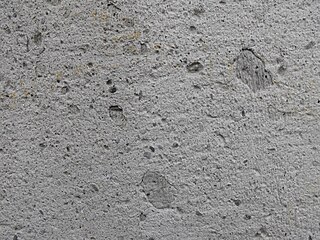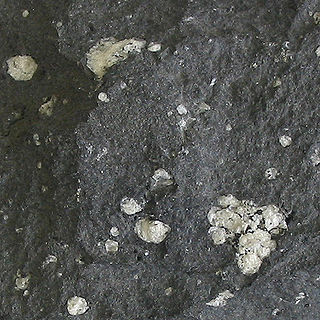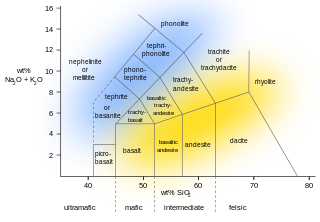
Basalt is an aphanitic (fine-grained) extrusive igneous rock formed from the rapid cooling of low-viscosity lava rich in magnesium and iron exposed at or very near the surface of a rocky planet or moon. More than 90% of all volcanic rock on Earth is basalt. Rapid-cooling, fine-grained basalt is chemically equivalent to slow-cooling, coarse-grained gabbro. The eruption of basalt lava is observed by geologists at about 20 volcanoes per year. Basalt is also an important rock type on other planetary bodies in the Solar System. For example, the bulk of the plains of Venus, which cover ~80% of the surface, are basaltic; the lunar maria are plains of flood-basaltic lava flows; and basalt is a common rock on the surface of Mars.

Tuff is a type of rock made of volcanic ash ejected from a vent during a volcanic eruption. Following ejection and deposition, the ash is lithified into a solid rock. Rock that contains greater than 75% ash is considered tuff, while rock containing 25% to 75% ash is described as tuffaceous. Tuff composed of sandy volcanic material can be referred to as volcanic sandstone.

Rhyolite is the most silica-rich of volcanic rocks. It is generally glassy or fine-grained (aphanitic) in texture, but may be porphyritic, containing larger mineral crystals (phenocrysts) in an otherwise fine-grained groundmass. The mineral assemblage is predominantly quartz, sanidine, and plagioclase. It is the extrusive equivalent of granite.

Trachyte is an extrusive igneous rock composed mostly of alkali feldspar. It is usually light-colored and aphanitic (fine-grained), with minor amounts of mafic minerals, and is formed by the rapid cooling of lava enriched with silica and alkali metals. It is the volcanic equivalent of syenite.

Andesite is a volcanic rock of intermediate composition. In a general sense, it is the intermediate type between silica-poor basalt and silica-rich rhyolite. It is fine-grained (aphanitic) to porphyritic in texture, and is composed predominantly of sodium-rich plagioclase plus pyroxene or hornblende.

Phonolite is an uncommon shallow intrusive or extrusive rock, of intermediate chemical composition between felsic and mafic, with texture ranging from aphanitic (fine-grained) to porphyritic (mixed fine- and coarse-grained). Phonolite is a variation of the igneous rock trachyte that contains nepheline or leucite rather than quartz. It has an unusually high (12% or more) Na2O + K2O content, defining its position in the TAS classification of igneous rocks. Its coarse grained (phaneritic) intrusive equivalent is nepheline syenite. Phonolite is typically fine grained and compact. The name phonolite comes from the Ancient Greek meaning "sounding stone" due to the metallic sound it produces if an unfractured plate is hit; hence, the English name clinkstone is given as a synonym.

Extrusive rock refers to the mode of igneous volcanic rock formation in which hot magma from inside the Earth flows out (extrudes) onto the surface as lava or explodes violently into the atmosphere to fall back as pyroclastics or tuff. In contrast, intrusive rock refers to rocks formed by magma which cools below the surface.

Volcanic rocks are rocks formed from lava erupted from a volcano. Like all rock types, the concept of volcanic rock is artificial, and in nature volcanic rocks grade into hypabyssal and metamorphic rocks and constitute an important element of some sediments and sedimentary rocks. For these reasons, in geology, volcanics and shallow hypabyssal rocks are not always treated as distinct. In the context of Precambrian shield geology, the term "volcanic" is often applied to what are strictly metavolcanic rocks. Volcanic rocks and sediment that form from magma erupted into the air are called "pyroclastics," and these are also technically sedimentary rocks.

A magma chamber is a large pool of liquid rock beneath the surface of the Earth. The molten rock, or magma, in such a chamber is less dense than the surrounding country rock, which produces buoyant forces on the magma that tend to drive it upwards. If the magma finds a path to the surface, then the result will be a volcanic eruption; consequently, many volcanoes are situated over magma chambers. These chambers are hard to detect deep within the Earth, and therefore most of those known are close to the surface, commonly between 1 km and 10 km down.

A xenolith is a rock fragment that becomes enveloped in a larger rock during the latter's development and solidification. In geology, the term xenolith is almost exclusively used to describe inclusions in igneous rock entrained during magma ascent, emplacement and eruption. Xenoliths may be engulfed along the margins of a magma chamber, torn loose from the walls of an erupting lava conduit or explosive diatreme or picked up along the base of a flowing body of lava on the Earth's surface. A xenocryst is an individual foreign crystal included within an igneous body. Examples of xenocrysts are quartz crystals in a silica-deficient lava and diamonds within kimberlite diatremes. Xenoliths can be non-uniform within individual locations, even in areas which are spatially limited, e.g. rhyolite-dominated lava of Niijima volcano (Japan) contains two types of gabbroic xenoliths which are of different origin - they were formed in different temperature and pressure conditions.

A phenocryst is an early forming, relatively large and usually conspicuous crystal distinctly larger than the grains of the rock groundmass of an igneous rock. Such rocks that have a distinct difference in the size of the crystals are called porphyries, and the adjective porphyritic is used to describe them. Phenocrysts often have euhedral forms, either due to early growth within a magma, or by post-emplacement recrystallization. Normally the term phenocryst is not used unless the crystals are directly observable, which is sometimes stated as greater than 0.5 mm (0.020 in) in diameter. Phenocrysts below this level, but still larger than the groundmass crystals, are termed microphenocrysts. Very large phenocrysts are termed megaphenocrysts. Some rocks contain both microphenocrysts and megaphenocrysts. In metamorphic rocks, crystals similar to phenocrysts are called porphyroblasts.

The Anahim Volcanic Belt (AVB) is a west–east trending chain of volcanoes and related magmatic features in British Columbia, Canada. It extends from Athlone Island on the Central Coast, running eastward through the strongly uplifted and deeply dissected Coast Mountains to near the community of Nazko on the Interior Plateau. The AVB is delineated as three west-to-east segments that differ in age and structure. A wide variety of igneous rocks with differing compositions occur throughout these segments, comprising landforms such as volcanic cones, volcanic plugs, lava domes, shield volcanoes and intrusions.

Carbonatite is a type of intrusive or extrusive igneous rock defined by mineralogic composition consisting of greater than 50% carbonate minerals. Carbonatites may be confused with marble and may require geochemical verification.

Komatiite is a type of ultramafic mantle-derived volcanic rock defined as having crystallised from a lava of at least 18 wt% magnesium oxide (MgO). It is classified as a 'picritic rock'. Komatiites have low silicon, potassium and aluminium, and high to extremely high magnesium content. Komatiite was named for its type locality along the Komati River in South Africa, and frequently displays spinifex texture composed of large dendritic plates of olivine and pyroxene.

San Pietro Island is an island approximately seven kilometres off the South western Coast of Sardinia, Italy, facing the Sulcis peninsula. With an area of 51 square kilometres it is the sixth-largest island of Italy by area. The approximately 6,000 inhabitants are mostly concentrated in the fishing town of Carloforte, the only comune in the island. It is included in the province of South Sardinia. It is named after Saint Peter.

Level Mountain is a large volcanic complex in the Northern Interior of British Columbia, Canada. It is located 50 kilometres north-northwest of Telegraph Creek and 60 kilometres west of Dease Lake on the Nahlin Plateau. With a maximum elevation of 2,164 metres, it is the second-highest of four large complexes in an extensive north–south trending volcanic region. Much of the mountain is gently-sloping; when measured from its base, Level Mountain is about 1,100 metres tall, slightly taller than its neighbour to the northwest, Heart Peaks. The lower, broader half of Level Mountain consists of a shield-like structure while its upper half has a more steep, jagged profile. Its broad summit is dominated by the Level Mountain Range, a small mountain range with prominent peaks cut by deep valleys. These valleys serve as a radial drainage for several small streams that flow from the mountain. Meszah Peak is the only named peak in the Level Mountain Range.

Pantellerite is a type of volcanic rock, specifically a peralkaline rhyolite. It has a higher iron and lower aluminium composition than comendite. It is named after Pantelleria, a volcanic island in the Strait of Sicily and the type location for this rock. On Pantelleria the rock is usually found as a vitrophyre containing phenocrysts of anorthoclase or sanidine. Quartz is found only in the most strongly peralkaline rocks. Mafic minerals may include aegirine, fayalite, aenigmatite, ilmenite, and sodic amphibole.

Peralkaline rocks include those igneous rocks which have a deficiency of aluminium such that sodium and potassium are in excess of that needed for feldspar. The presence of aegerine and riebeckite are indicative of peralkaline conditions. Examples are the peralkaline rhyolites, comendite and pantellerite, with comendite being the more felsic (silica-rich) rock. Another example is the peralkaline granite that forms the islet of Rockall in the North Atlantic Ocean.

Igneous rock, or magmatic rock, is one of the three main rock types, the others being sedimentary and metamorphic. Igneous rocks are formed through the cooling and solidification of magma or lava.
The alkaline magma series is a chemically distinct range of magma compositions that describes the evolution of an alkaline mafic magma into a more evolved, silica-rich end member.



















